Falkland Islands, South Georgia & Antarctic Peninsula | Trip Itinerary
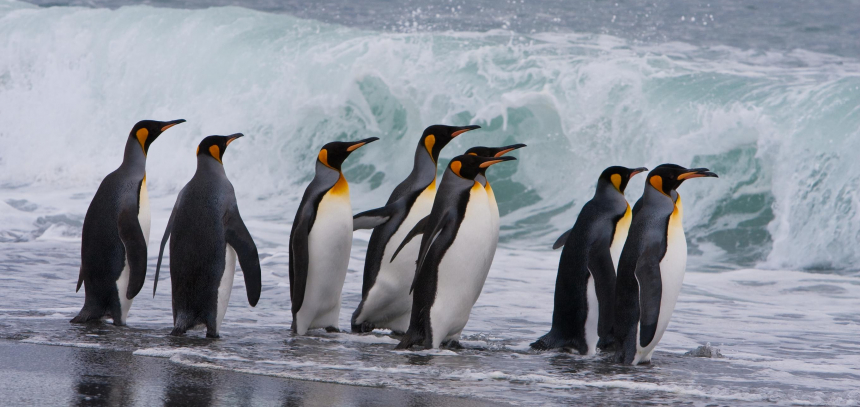
A typical itinerary to the Falklands, South Georgia and the Antarctic Peninsula is illustrated below. All itineraries are for guidance only. Programs may vary depending on local ice and weather conditions, the availability of landing sites and opportunities to see wildlife. The final itinerary will be determined by the Expedition Leader on board. Flexibility is paramount for expedition cruises.
Go to: More Falkland Islands Info | More South Georgia Info | Route Map
Day 1: Ushuaia - In the afternoon, we embark in Ushuaia, Tierra del Fuego, Argentina, the southernmost city in the world located at the Beagle Channel and sail through this scenic waterway for the rest of the evening.
Day 2: At sea - In the Westerlies the ship is followed by several species of albatrosses, storm petrels, shearwaters and diving petrels.
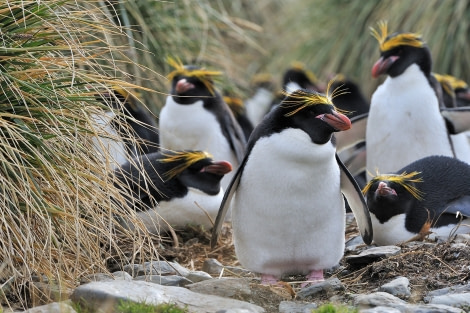 Day 3: Falkland Islands - In the Falkland Islands (Malvinas) we plan to spend the whole day on the fascinating western side of the archipelago. A hike along the Shore of Carcass Island will give us views of Magellanic and Gentoo-Penguins, as well as close encounters with water fowl and Night herons and passerines. In addition, on Saunders we will be able to observe four species of breeding penguins (Gentoo, King, Magellanic and Rockhopper), Black-browed Albatrosses and King Cormorants.
Day 3: Falkland Islands - In the Falkland Islands (Malvinas) we plan to spend the whole day on the fascinating western side of the archipelago. A hike along the Shore of Carcass Island will give us views of Magellanic and Gentoo-Penguins, as well as close encounters with water fowl and Night herons and passerines. In addition, on Saunders we will be able to observe four species of breeding penguins (Gentoo, King, Magellanic and Rockhopper), Black-browed Albatrosses and King Cormorants.
Day 4: Stanley, Falkland Islands - In Stanley, the capital of the Falklands, we can experience Falkland culture, which has some South American characteristics as well as Victorian charm. In Stanley and the surrounding area we can see quite an important number of stranded clippers from a century ago. All passengers are free to wander around on their own. We recommend a visit to the local church and museum (admission fees not included).
Days 5 & 6: At sea - On our way to South Georgia we will cross the Antarctic Convergence. Entering Antarctic waters, the temperature will drop by as much as 10 degrees C in the time span of only a few hours. Near the Convergence we will see a multitude of southern seabirds near the ship; several species of Albatrosses, Shearwaters, Petrels, Prions and Skuas.
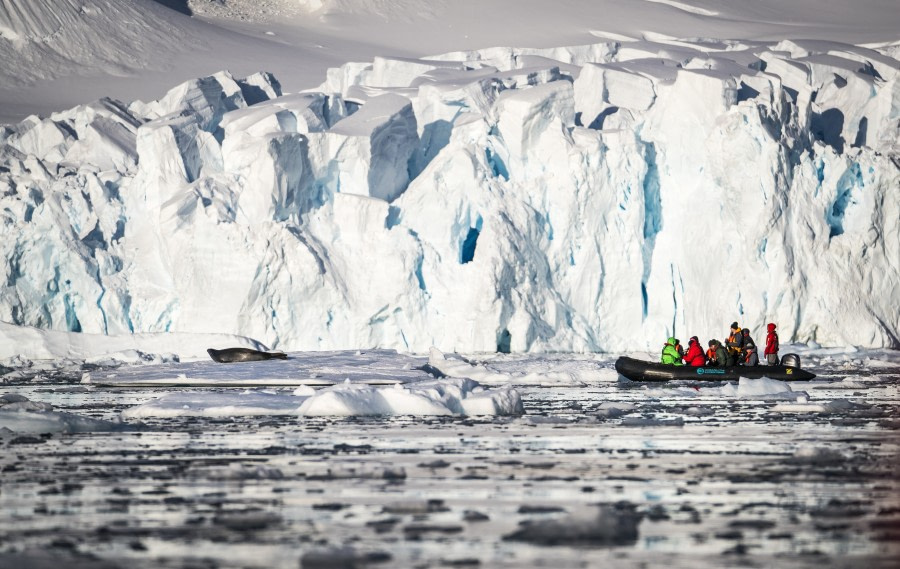 Days 7 – 10: South Georgia - Today you arrive at the first South Georgia activity site. Please keep in mind that weather conditions in this area can be challenging, largely dictating the program. Over the next several days, you have a chance to visit the following sites:
Days 7 – 10: South Georgia - Today you arrive at the first South Georgia activity site. Please keep in mind that weather conditions in this area can be challenging, largely dictating the program. Over the next several days, you have a chance to visit the following sites:
Prion Island – This location is closed during the early part of the wandering albatross breeding season (November 20 – January 7). From January on, the breeding adults have found their partners and are sitting on eggs or nursing their chicks. Enjoy witnessing the gentle nature of these animals, which possess the largest wingspan of any bird in the world.
Fortuna Bay – A beautiful outwash plain from Fortuna Glacier is home to a large number of king penguins and seals. Here you may also have the chance to follow the final leg of Shackleton’s route to the abandoned whaling village of Stromness. This path cuts across the mountain pass beyond Shackleton’s Waterfall, and as the terrain is partly swampy, be prepared to cross a few small streams.
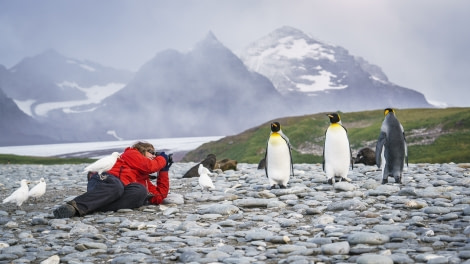 Salisbury Plain, St. Andrews Bay, Gold Harbour – These sites not only house the three largest king penguin colonies in South Georgia, they’re also three of the world’s largest breeding beaches for Antarctic fur seals. Literally millions breed on South Georgia during December and January. Only during the mid-season do they peak in their breeding cycle. There will be some young adult Elephant seals as well as this seasons ‘Weaner’s; the young Elephant Seals that have been left to fend for themselves. Watch your step and stay cool when walking the beaches during this time.
Salisbury Plain, St. Andrews Bay, Gold Harbour – These sites not only house the three largest king penguin colonies in South Georgia, they’re also three of the world’s largest breeding beaches for Antarctic fur seals. Literally millions breed on South Georgia during December and January. Only during the mid-season do they peak in their breeding cycle. There will be some young adult Elephant seals as well as this seasons ‘Weaner’s; the young Elephant Seals that have been left to fend for themselves. Watch your step and stay cool when walking the beaches during this time.
Grytviken – In this abandoned whaling station, king penguins walk the streets and elephant seals lie around like they own the place – because they basically do. Here you might be able to see the South Georgia Museum as well as Shackleton’s grave.
In the afternoon of day 10 and depending on the conditions, we will start sailing southwards in the direction of the South Orkney Islands.
Day 11: At sea - Where the ship is again followed by a multitude of seabirds. At some point we might encounter sea-ice, and it is at the ice-edge where we might have a chance to see some high-Antarctic species like the McCormick Skua and Snow Petrel.
Day 12: South Orkney Islands - We are planning on a visit to Orcadas station, an Argentinean base located in the South Orkney Islands. The friendly base personnel will show us their facilities and we can enjoy the wonderful views of the surrounding glaciers.
For Solar Eclipse Voyage/Dec 4: Weddell Sea pack ice & total solar eclipse (Dec 4/Early morning)
The ship positions itself in the center of the shadow of the moon, and if possible, some distance into the Scotia Sea drift ice. The ice edge will be about 60°S, 41°W.
Some coordinates for the path of the moon’s shadow:
7.06 UTC: 58º 47.7' S – 42º 45.2' W, 1' 39" , 8 degrees above horizon
7.08 UTC: 60º 42.4' S – 40º 59.8' W, 1' 42" , 9 degrees above horizon
7.10 UTC: 62º 22.3' S – 39º 48.0' W, 1' 44", 11 degrees above horizon
Day 13: At sea
Days 14 – 17: Antarctic Peninsula - If the ice conditions permit, you now sail into the Weddell Sea. Here colossal tabular icebergs herald your arrival to the eastern side of the Antarctic Peninsula. Paulet Island, with its large population of Adélie penguins, is a possible stop. You might also visit Brown Bluff, located in the ice-clogged Antarctic Sound, where you could get the chance to set foot on the Antarctic Continent itself.
If conditions aren’t favorable to enter the Weddell Sea from the east, the ship will set course for Elephant Island and head into the Bransfield Strait, between the South Shetland Islands and the Antarctic Peninsula. Here you can attempt to access the Antarctic Sound from the northwest.
The breathtaking scenery continues in the Bransfield Straight and, if conditions allow further South in the Gerlache Strait. Conditions on the Drake Passage determine the exact time of departure.
Days 18-19: At sea - On our way north we are again followed by a great selection of seabirds while crossing the Drake Passage.
Day 20: Ushuaia - Every adventure, no matter how grand, must eventually come to an end. It’s now time to disembark in Ushuaia, but with memories that will accompany you wherever your next adventure lies.
(B=Breakfast, L=Lunch, D=Dinner)
More about the Falkland Islands
Although officially south-Atlantic, the Falkland Islands surely have a sub-Antarctic appeal. The archipelago is a treasure-chest for Antarctica-minded nature lovers and photographers. The islands are full of wildlife, with vast colonies of Black-browed Albatross, five species of penguins, Elephant Seals and much more. They are one of the last "off the beaten track" destinations. Unfortunately the Falkland Islands have an undeserved bad reputation, mainly because of the Falkland War in 1982 so that many people do not know that the islands have much more to offer then just minefields. The Falklands offer a broad variety of spectacular wildlife, rough scenery, fascinating geology, maritime history, good hiking and, of course, the warm hospitality of the people.
The Falkland Islands are located about 500 kilometres (300 miles) east of Argentina, at Latitude 52º South. They consist of about 800 islands. The two main islands, East Falkland and West Falkland, make up the majority of the area, being comparable in size with Jamaica or Northern Ireland. The landscape is generally hilly and reminds visitors of the lower Scottish Highlands . That might have been the reason that settlers from Scotland and Wales felt at home on these remote islands. Even the weather has a resemblance to that of northern Scotland.
The Falkland Islands might have been visited by natives from Tierra del Fuego, though this is not certain. One of the first sightings by a westerner was that of the famous British navigator and Arctic explorer John Davis in 1592. The first settlement on the islands was founded by the French navigator and explorer Louis-Antoine de Bougainville in 1764. De Bougainville landed with French settlers from the French town of St. Malo and founded the village of Port Saint Louis on Berkeley Sound in East Falkland. They named the islands "Îles Malouines", after the home town of many of the settlers, and this is why the Falklands are sometimes referred to as the "(Islas) Malvinas", as Spain later took over the French settlement and claimed the archipelago. Since 1833 the archipelago has been British, but sovereignty is still disputed by Argentina.
Stanley
Stanley, also still known under its former name Port Stanley, is the administrative centre of the archipelago. About three-quarters of the total population of the islands, which is about 2500, lives in the town. Originally Stanley was a tiny, insignificant outpost, but then, in the 19th and early 20th century, it grew in importance as a repair port for sailing-ships rounding Cape Horn. The severe storms around Cape Horn often damaged ships which then used Port Stanley for repairs. Ships that were in a too bad state were often scuttled in the harbour; several old shipwrecks near Stanley being a reminder of those days. After the Panama Canal was built in 1914 the Cape Horn route became obsolete and Stanley returned to its former insignificant existence, living mainly from the export of wool. But since 1982 Stanley has boomed again. It started with the British military forces that were stationed near the town, but later the Falkland Islands made money by selling fishing licenses to foreign fishing vessels that want to fish in the island waters. The Falkland islanders are nowadays fairly prosperous.
Climate
The Falkland Islands experience a cool Oceanic Climate. It is often windy because the islands are situated in the stormy latitudes of the southern westerly winds or "Roaring Forties". Temperatures usually range between 5º and 10ºC (40º and 50ºF). There is little rainfall but rain and sleet can occur any time of the year.
Flora and Fauna
Because of the isolated location of the islands some unique flora and fauna species have developed. The dramatic cliff coasts, the white sandy beaches and the sheltered Tussock grass make excellent breeding grounds for numerous animal species. Around 60 bird species regularly breed on the islands and several endemic species can be found such as Cobb's Wren and the Falkland Pipit.
You may even encounter the rare and remarkable Striated Caracara, locally known as Johnny Rook. This inquisitive bird has a reputation for being the rogue of the bird world, hanging around bird colonies in search of eggs, chicks and even adult birds. A visit to a Black-browed Albatross colony is also an unforgettable experience. Five penguin species are also represented on the islands, three of which you will not find in Antarctica - Rockhopper, Magellanic and King Penguins. The list of marine mammal species is extensive. Southern Elephant Seal, South American Fur Seal, Southern Sea Lion, Killer Whale, Commerson's Dolphin and Peale's Dolphin are seen frequently. Offshore baleen whales are seen in increasing numbers.
Frequently Visited Places:
• New Island (south), in the far west of the archipelago, offers some great wildlife opportunities. The island is a wildlife reserve. It hosts a unique colony of Black-browed Albatrosses, Rockhopper Penguins and Blue-eyed Cormorants all nesting together.
• Carcass Island, in the north-west of the archipelago, is owned by Rob and Lorraine McGill. The traditional island high-tea with home-baced cakes and cookies should not be missed. A hike along the shore will give good views of Magellanic and Gentoo Penguins.
• Saunders Island. A dramatically set island located in the north of the archipelago. The island has a large variety of wildlife. Four species of penguins can be found here as well as a colony of 11,000 breeding pairs of Black-browed Albatrosses.
• Stanley, the capital of the Falkland Islands, still has the atmosphere of a Scottish coastal village. Shipwrecks, Landrovers, small houses with coloured roofs and traditional British pubs enhance the village setting. The town has several shops, a bank, hotels as well as the pubs. Special Island stamps are for sale and there is an excellent museum on the history of the islands. In the vicinity there are nice walking areas with a colony of Magellanic Penguins and other interesting bird species.
More about South Georgia
The island of South Georgia is one of the remotest and wildest places of the United Kingdom's Overseas Territories. It is located 1400 kilometres (850 miles) to the east of the Falkland Islands. South Georgia does not have an airport, the only access is by ship and it takes two whole days to reach from the Falkland Islands. The island measures approximately 170 kilometres (106 miles) by 30 kilometres (18 miles) and is completely mountainous, its snow-capped mountains rising to 2934 metres (9626 feet). The island has more than 160 glaciers dropping down into the sea. The landscape reminds visitors of the fjord coasts of Norway, one reason, perhaps, why Norwegian whalers felt at home during the whaling period.
Huge numbers of seabirds and marine mammals breed along South Georgia's Tussock Grass fringed shores. Save for the rusting remnants of the old whaling stations, the island is virtually unspoilt by man and so offers unique opportunities to observe the unparalleled wildlife and spectacular scenery of this most beautiful part of the Southern Ocean, a true Antarctic oasis.
The first recorded landing on South Georgia was made by the British explorer James Cook, who discovered the island on his second voyage around the world. Hoping to find the long sought Southern Continent he was very disappointed to find that South Georgia was just an island. Cook landed in Possession Bay and claimed the island for the United Kingdom. Cook wrote: "...A country doomed by nature never once to feel the warmth of the sun's rays, but to lie for ever buried under everlasting snow and ice."
Soon after James Cook, Fur Seal and Elephant Seal hunters found their way to South Georgia, exploiting the animals for their furs and oil. In the beginning of the 20th century South Georgia became the centre of the Southern Ocean whaling industry. Mainly Norwegian, but also British companies, built settlements and whaling stations in the sheltered fjords. The business lasted until 1964, by which time most of the whales were caught and populations were low. Nowadays the whales and seals are fully protected. The Fur and Elephant Seal populations have recovered and are again numerous on the beaches. The big whale species are also recovering, but slowly, and are now frequently spotted on our trips.
Climate
South Georgia is located within the Antarctic Convergence, an oceanographic border that separates the cold Southern Ocean from the warmer northern Oceans. Therefore South Georgia experiences a cold Oceanic Climate. The weather can be very variable. Blue skies with sunshine can be succeeded by violent storms within half an hour. The average summer temperature at sea level is around 7.5°C (45°F). Rain and snow are possible in any season.
Flora and Fauna
When the abundance of wildlife is considered South Georgia can only be compared with places like the Galapagos Islands. The sheer number of penguins, petrels and seals is unequalled in the world. The island is home to truly millions of seabirds and seals. The sight of tens of thousands of King Penguins on Salisbury Plain and in St. Andrew's Bay is unforgettable. But it is not only in numbers that the island can boast several records. It is also home to the largest flying bird species in the world, the enormous Wandering Albatross, and the largest seal species, the Southern Elephant Seal.. Other animals that are often seen are: Reindeer (introduced), Gentoo Penguins, Macaroni Penguins, Grey-headed Albatrosses, Light-mantled Sooty Albatrosses, Northern and Southern Giant Petrels, White-chinned Petrels, several species of prions and storm petrels, Brown Skuas, Dominican Gulls, Antarctic Terns, Sheathbills and endemic South Georgia Pintails.
Frequently visited places
• Bay of Isles with breeding Wandering Albatrosses on Prion Island, and Salisbury Plain with one of the largest King Penguin colonies in the world.
• Fortuna Bay. A scenic fjord into which Shackleton descended during his epic crossing of the island in 1916. The last leg of this walk is sometimes retraced On our trips. There is a nice King Penguin colony at the head of the bay.
• Grytviken is an abandoned Norwegian whaling station. It bears testimony to a less environmentally conscious era. Nowadays King Penguins can be seen walking down the street and Elephant Seals and Fur Seals have retaken the beaches. There is a great museum on the natural history and the whaling period. Sir Ernest Shackleton was buried at Grytviken in 1922. A toast (with whisky preferably) at his grave is a tradition with travellers.
• St. Andrews Bay. South Georgia's largest King Penguin colony with approximately 150,000 breeding pairs. The bay is very exposed so that landing is not always possible.
• Gold Harbour is the abridged version of South Georgia's wildlife and scenery in one place. It is regarded by many as the most beautiful place of the island. King Penguins, Gentoo Penguins and Elephant Seals are the players in this natural amphitheatre.
• Drygalski Fjord is a wild, rugged fjord at the far east site of the island. Ice and rock dominate the landscape. A ship-cruise into the fjord often completes the visit to South Georgia
Route Map:
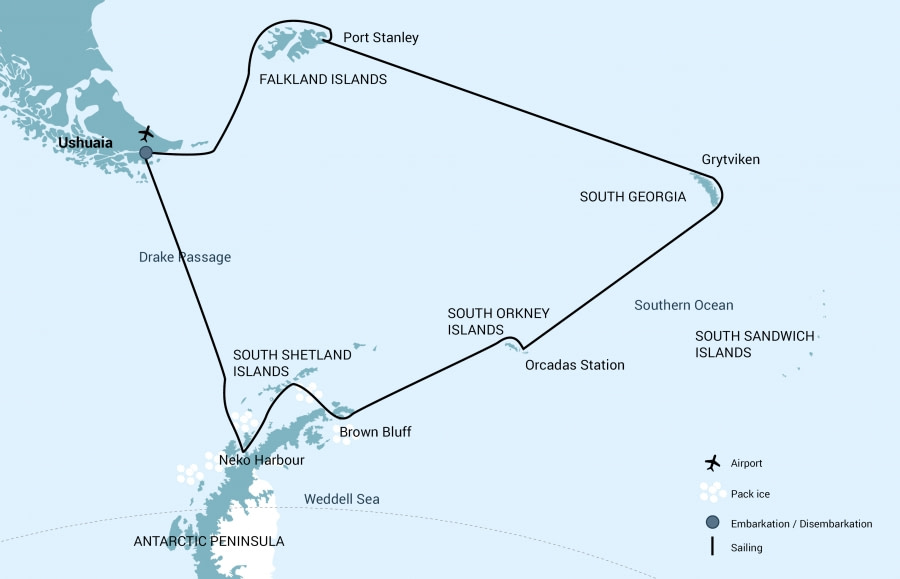
Departures
Nov 23-Dec 11
Jan 4-22
Jan 16-Feb 3
2023:
Quad from $13,500 pp
Twins from $13,500 pp
Deluxe from $18,350 pp
Superior from
$19,650 pp
2024
Quad from $15,750 pp
Twins from $19,000pp
Deluxe from $21,100 pp
Superior from
$22,700 pp
